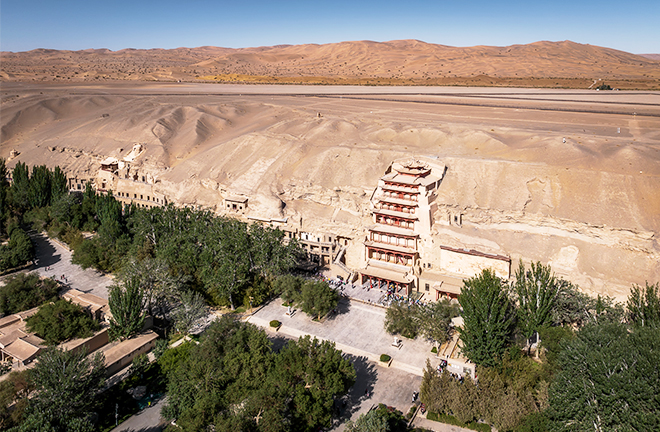Development and challenges of digital art

Digital art allows artworks to be more accessible, like “Digital Dunhuang.” Photo: TUCHONG
The impact of digital technology on future art is profound, with several notable trends emerging.
First, artistic creation will become more accessible. Digital art has significantly lowered the barriers to creation, and with the right equipment and software, anyone can create a piece of music. The same is true for other forms of art as well—where creation is unrestricted and unlimited, and any artistic idea can be realized to some extent.
Second, a large number of digital humans will participate in artistic performances. These future digital beings will possess advanced thinking and problem-solving capabilities, enabling them to engage in sophisticated artistic endeavors.
Third, digital art allows for creations that are “endless.” Unlike traditional art, digital artworks can remain dynamic and evolving. As digital technology continues to develop, the “dynamic” nature of such creations will become increasingly prominent.
Fourth, artistic presentations will be unrestricted by time and space. We know that many of the world’s most treasured artworks remain inaccessible to the majority due to various constraints. Digital technology can overcome these barriers. For example, since the early 1990s, when renowned scholar of Dunhuang Studies Fan Jinshi proposed the concept of “Digital Dunhuang,” the Dunhuang Academy’s cultural heritage digitalization team has been photographing the murals and creating digital reproductions, which have subsequently enabled virtual tours, multimedia presentations, data management, and art design. In 2014, the Dunhuang Academy held its first digital exhibition of Dunhuang art at its branch in Lanzhou, Gansu Province. To date, nearly 40 such exhibitions have been held both at home and abroad, allowing audiences to fully appreciate and experience the charm of Dunhuang art from all angles, and in a comprehensive way.
Everything should be viewed from both sides, and while digital art offers numerous advantages, we must not overlook its potential negative effects.
First, the boundary between technology and art becomes increasingly blurred. Technology, developed by humans to solve practical problems through the manipulation of nature, is primarily a means or methodological principle for meeting specific needs. On the other hand, artists, with their unique styles and methods, use literature and other forms of expression to create richly meaningful images to reflect society, convey ideas, and evoke emotions. In some digital art forms today, however, we see an overwhelming focus on clever techniques, with the core human element often missing.
Second, there is a risk of diminishing human creativity. It is well known that great art is the product of creation, not mere imitation or replication. Creativity is rooted in cultural and artistic cultivation. Creativity mainly thrives on keen observation, high sensibilities, vivid imagination, and unique memory. However, in future digital art, tools, especially as AI develops, may become the primary drivers of creation, potentially stifling human artistic creativity.
Third, the rise of digital art may disrupt the art market. A stable and regulated art market is essential for supporting artistic creation, and if it becomes too chaotic or unregulated, it will negatively affect artists and their work. In the future digital art era, intellectual property rights will face huge challenges, posing risks to the integrity of the market.
Of course, these negative effects will be addressed, or at least minimized, through effective solutions. The development of digital technology is an unstoppable historical trend, and no force can halt its forward progress. Digital art, as an extension of this technological evolution, represents the future direction of the art world. The appropriate response is not to resist, but to adapt and actively engage in shaping its healthy development. By doing so, we can ensure that digital art flourishes in a positive and sustainable way.
Zhu Hengfu is a professor from the Film-Television and Communication College at Shanghai Normal University.
Edited by ZHAO YUAN
